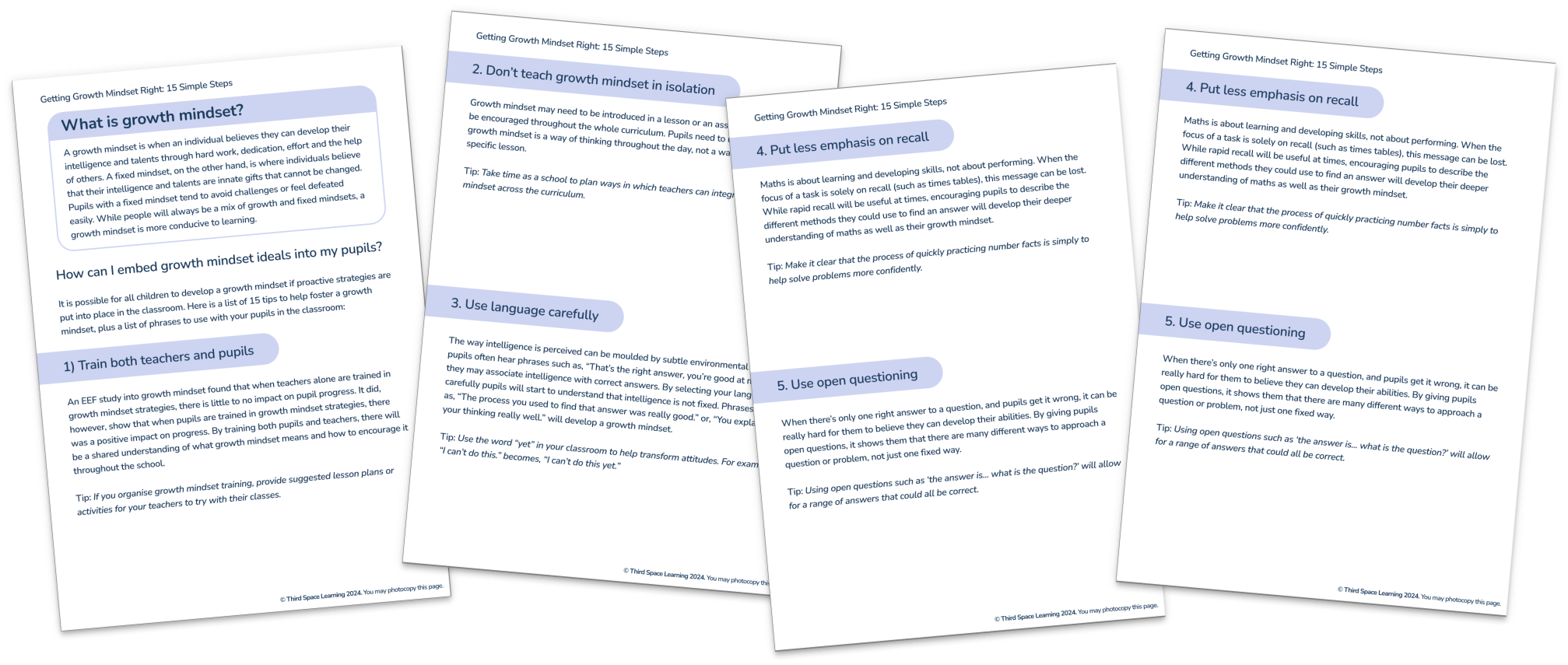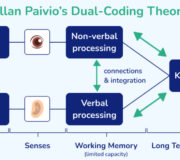Cognitive Load Theory: A Practical Guide And Tips For Teachers
Cognitive load theory can help teachers plan lessons and design materials that avoid cognitive overload, resulting in more effective learning.
This article will examine why cognitive load theory is so important in education, how teachers can reduce demands on their students’ working memory and the practical applications of the theory to enhance learning in the classroom.
What is cognitive load theory?
Cognitive load theory is primarily concerned with how information is efficiently and effectively encoded into learners’ long-term memory. For education, cognitive load theory (CLT) refers to how teachers and students can manage and process tasks to significantly improve learning and memory.
Cognitive load theory was developed by John Sweller in the 1980s and is widely supported by educational psychologists, theorists and research. The theory integrates human cognitive architecture (the organisation of cognitive processes, such as memory) with practical classroom applications.
The integration of theory and practice and the demonstrable impact on learning outcomes through educational research makes cognitive load theory a game-changer for teachers’ classroom practice.
To understand cognitive load theory and the ideas behind it, we must first understand how we process information and how this affects learning.
Getting growth Mindset Right
15 practical ideas every school leader and teacher can use to encourage growth mindset in their school and classroom
Download Free Now!Human cognitive architecture
Cognitive science aims to understand information processing, organisation and encoding. Early theorists, such as Atkinson and Shiffrin, developed models of human cognitive architecture that identified three types of memory:
- Sensory memory
- Short-term memory
- Long-term memory.
This multi-store model of memory describes how the amount of information that can be stored at each stage increases, as does the duration of each store (Meyer, 1996).
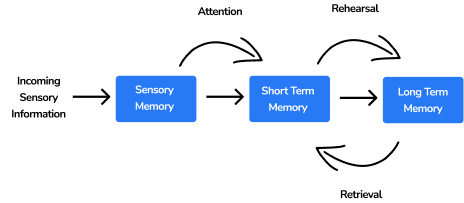
Sensory memory
The sensory memory processes all stimuli received through our senses but only for a split second. Information that needs attention for longer than this must be transferred to the short-term memory.
Short term memory
The short term memory has a limited capacity (between 5 and 9 pieces of information) and duration (approximately 30 seconds). If information is required for longer than this, it must either be repeated or rehearsed in the short term memory or transferred to the long term memory.
Long term memory
The long term memory store is theoretically unlimited in capacity and duration.
Learning is said to have occurred when information is successfully encoded into the long-term memory in a way that allows learners to retrieve the information when it is required.
What does human cognitive architecture look like in the maths classroom?
In a mathematics lesson, students process everything through their sensory memory:
- the temperature of the room
- noises from outside
- what the two people are talking about in the row behind them
- where the teacher is standing
- what is written on the board
- where their calculator is on the desk
- the colour of the chairs
- the posters on the wall…
The sensory memory filters everything for its importance and disregards almost everything within a split second.
Students will most likely split their attention between what the teacher is saying and what is written on the board. These two sources of information will be processed in the short-term memory.
They won’t be able to quote everything the teacher said at the end of the lesson, but during the lesson they will be able to interact with what is said and could probably repeat the last 30 seconds of speech at any point during the lesson.
It is only the information that students make a decisive effort to learn that will be encoded into their long term memory. For example, they may remember that ‘opposite angles add up to 180⁰’ but they may forget that the shape is called a ‘cyclic quadrilateral’.
The working memory model
The working memory model was developed by Baddeley and Hitch (1974) to explain the internal cognitive processes in the short term memory.
It explains how our working memory capacity and processing capacity can be increased or decreased depending on the sources of information it is presented with.
- Central executive: The central executive manages the interaction of material from the different working memory components, directs attention, and manages the transfer of new information into the long-term memory.
- Visuo-spatial sketchpad: The visuo-spatial sketchpad processes images and the location of items relative to other stimuli. For example, when deciding whether an image has been transformed by reflection, rotation, translation, or enlargement.
- Phonological loop: The phonological loop processes auditory information such as speech. It also processes the ‘inner voice’ that occurs when reading text. The phonological loop can become overloaded if a pupil is reading from the board while their teacher is talking.
- Episodic buffer: The episodic buffer is used to recall information from the long term memory that is relevant to the cognitive tasks being performed. For example, a student may need to retrieve information about equivalent fractions when asked to add two fractions together.
Learners’ working memory is the gateway to their long term memory. Information is processed according to its modality.
The working memory capacity is limited and becomes overloaded quickly, known as cognitive overload.
Therefore, teachers must avoid cognitive overload to enable learners to efficiently transfer new information into their long term memory.

Meet Skye, the voice-based AI tutor making maths success possible for every student.
Built by teachers and maths experts, Skye uses the same pedagogy, curriculum and lesson structure as our traditional tutoring.
But, with more flexibility and a lower cost, schools can scale online maths tutoring to support every student who needs it.
Watch Skye in actionWhat are the different types of cognitive load?
In addition to working memory load, the theory recognises three other types of cognitive load:
- Intrinsic load
Intrinsic cognitive load refers to the mental effort required to complete a task, which is influenced by the task difficulty and expertise of the learner. - Extraneous load
Extraneous cognitive load is caused by the instructional design or the way a task is presented. - Germane load
Germane cognitive load refers to the cognitive resources that directly enhance learning, such as the effort required for schema construction or to automate new processes.
It is difficult to change the intrinsic load of a task, but it is possible to reduce the extrinsic load of a task so that students can invest more effort and resources into increasing their germane load (Merrienboer and Ayres, 2005).
How can teachers reduce the extraneous cognitive load of learning activities?
As teachers, we can reduce the extrinsic load of tasks by considering:
- How learning materials are presented: For example, a multimedia PowerPoint slide that contains redundant or distracting information requires additional effort from learners to select the relevant information.
- The physical learning environment: Extraneous load increases in the presence of physical distractions, such as wall displays, music, or the proximity of a student’s mobile phone.
- How to provide opportunities to activate prior knowledge: Access to a relevant schema or prior knowledge can reduce the intrinsic cognitive load required to complete a new task.
- How we sequence lessons: Design schemes of work and lesson sequences that incrementally increase in difficulty and build upon previous learning to decrease extraneous load.
- How we surface metacognition in lessons: Educating students about extraneous load can allow them to make changes to their learning environment so that their cognitive resources can be redirected to the germane load of the task.
If teachers do not carefully consider the demands of learning tasks in the classroom, students may experience cognitive overload.
Read more: Cognitive load theory in the classroom
What is cognitive overload?
Cognitive overload occurs when an element of the working memory or type of cognitive load reaches its capacity. This can occur in different ways, such as:
- When a student attempts to talk or listen when copying or reading from the board.
- When too much information is presented visually. This includes teachers and students moving around the room, looking out of the window, or irrelevant pictures on presentations or wall displays.
- If a task requires lots of unrelated prior knowledge to be recalled simultaneously.
- When the task is too complex for the expertise of the learner.
Cognitive overload is detrimental to the learning process because it reduces the cognitive resources available for germane load, which is directly responsible for learning new material and transferring it into the long term memory.
Like our traditional tutoring, our AI maths tutoring sessions with Skye help reduce cognitive overload by blurring the lesson content that learners don’t need to focus on. This means learners only take in the information relevant to the section of the problem they are working on. Read what deputy headteacher and primary education expert, Neil Almond, thought about Skye’s approach to cognitive load in his AI maths tutor review.
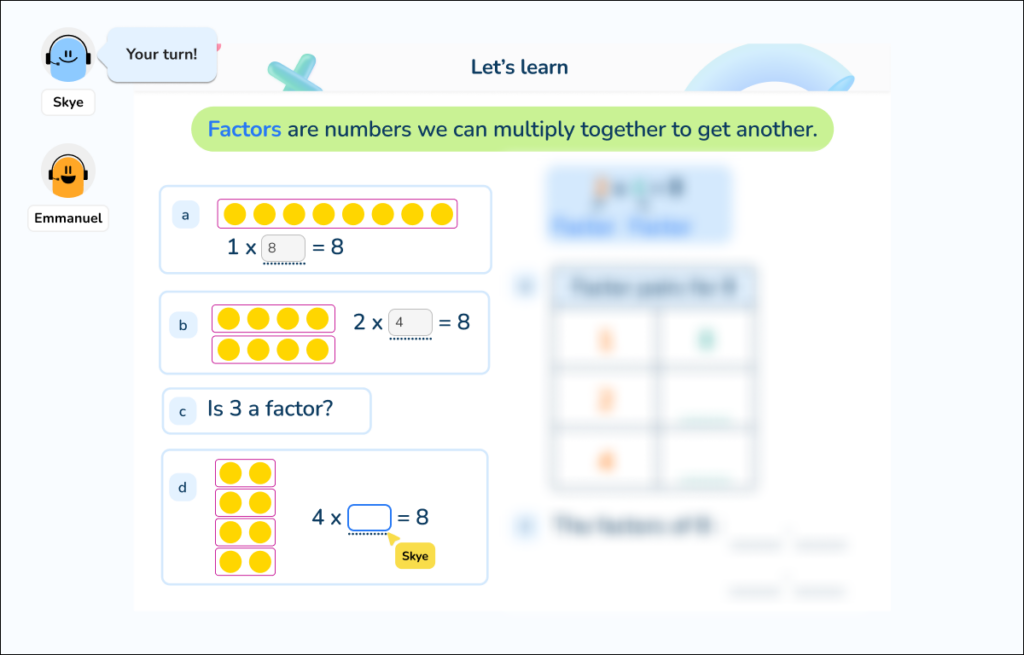
Read about cognitive overload for more information on how and why cognitive overload occurs, and what teachers can do in the classroom to avoid this.
How to apply cognitive load theory principles to improve learning outcomes
The following evidence-based effects are presented with practical implications to classroom practice. The teaching strategies listed below have been shown to successfully reduce students’ extraneous cognitive load, allowing more time and energy to be invested into germane load.
1. Goal-free effect
Students can become distracted by the end goal of a question, which prevents them from interacting with the question in a meaningful way.
Presenting problems without a specific goal is a useful strategy for the early stages of applying new information.
For example, present an image from an exam paper but without the corresponding question. This helps pupils to focus their attention on what they can deduce from the image rather than sharing their attention with the goal or purpose of the question.

Read more: Goal free problems
2. Worked example effect
When first presented with a novel problem, students can experience cognitive overload due to underdeveloped problem-solving strategies. Providing worked examples to introduce a new topic or strategy reduces the extraneous cognitive load of the task and allows pupils to focus all of their attention on studying and understanding each step of the method.
Solving linear equations with unknowns on both sides of the equals sign can be effectively taught through worked examples.
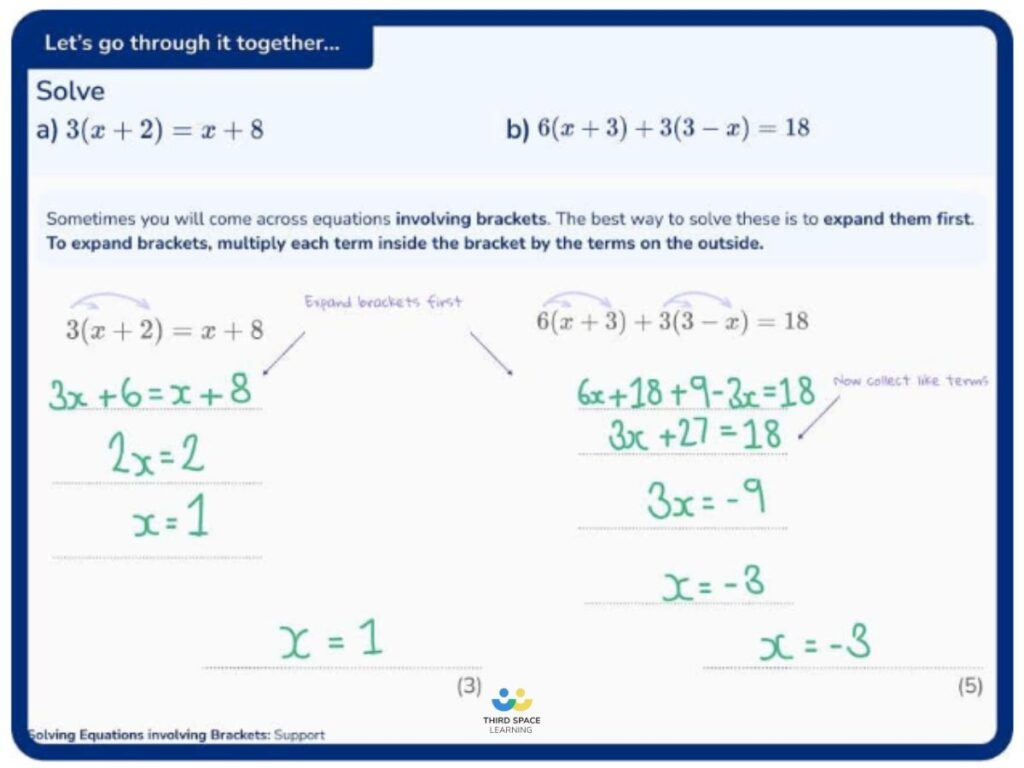
3. Completion problem effect
For the same reasons described above for the worked example effect, presenting pupils with a partially completed solution that requires them to complete only part of the method also increases the resources available for germane cognitive load.
This approach could be used for each step of a new strategy, such as solving linear equations, before asking students to reproduce the whole method independently.
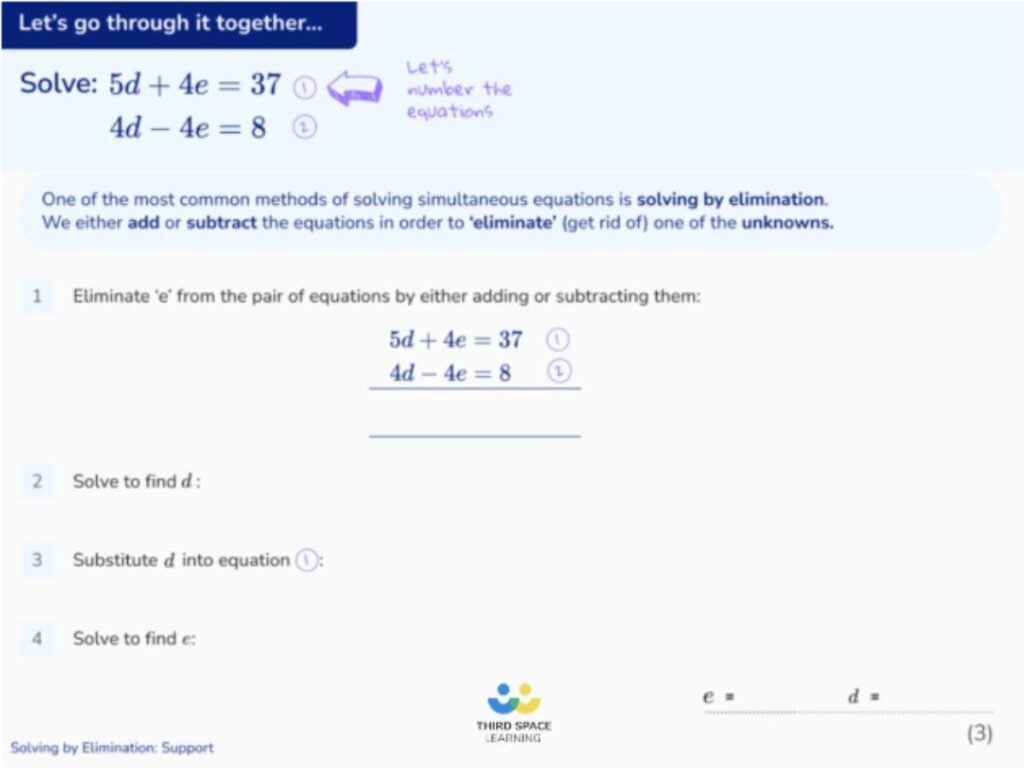
4. Split attention effect
Students often spend a lot of mental effort either discerning what information is most relevant to them or opting to split their attention between multiple sources of information to avoid missing something important.
The extraneous cognitive load this causes can be removed by teachers presenting information using a single or integrated source (Ayres and Paas, 2012). This can be achieved by the teacher using cueing techniques such as arrows on diagrams, fading out irrelevant parts of an image, or explicitly drawing attention to the key learning points in a lesson.
For example, a teacher may highlight a pair of parallel lines and a diagonal line going between them to focus students’ attention on that specific part of the diagram.
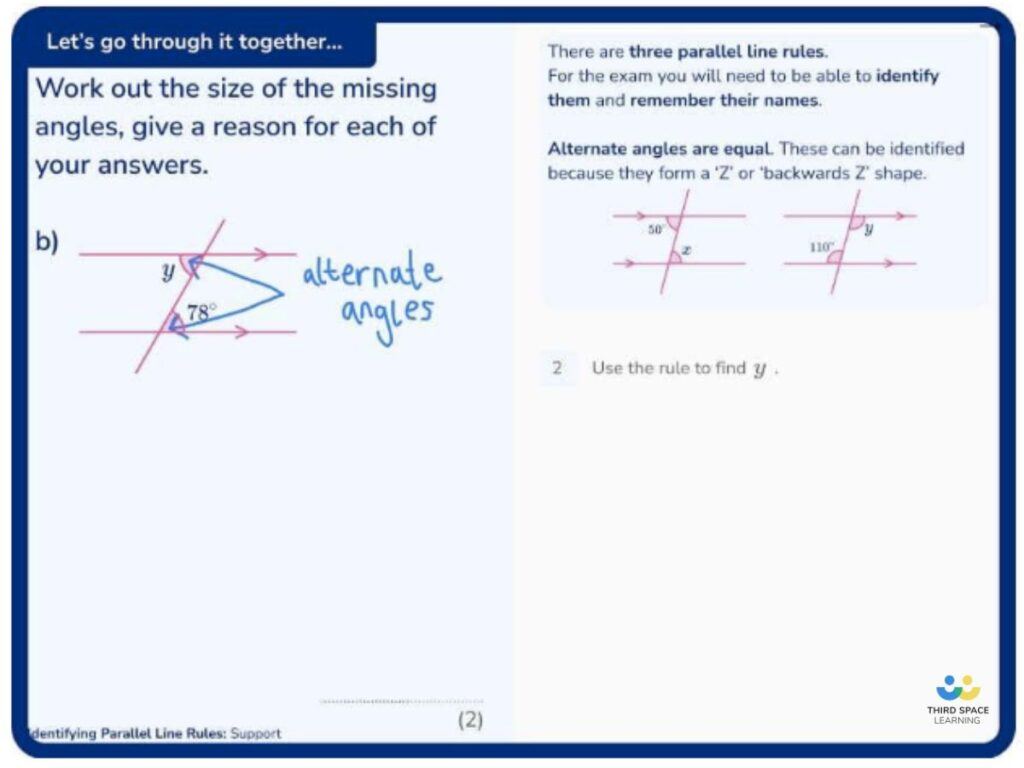
With Third Space Learning, pupils benefit from one to one maths tuition in a dedicated online classroom to work through GCSE style questions
5. Modality effect
Teachers can reduce extraneous cognitive load by presenting information to separate components within the working memory, rather than presenting two sets of information to the same component.
For example, written text and images are both processed by the visuo-spatial sketchpad. It is more effective to provide a spoken explanation that is processed by the phonological loop alongside an image that is being processed by the visuo-spatial sketchpad.
This means that when presenting a diagram to students, teachers should not ask students to annotate at the same time. Students should first listen to the teacher’s explanation, with the explanation processed by the phonological loop and the diagram processed by the visuo-spatial sketchpad. Following this, students can annotate the diagram.
6. Redundancy effect
Teachers should present students with just enough information to achieve the learning outcomes and avoid presenting information that is redundant to the lesson objectives to reduce extraneous load.
This includes unnecessary distractions, such as wall displays at the front of the classroom and images on PowerPoint presentations that are only used for decoration. Keeping slides clear and focused will also reduce the split attention effect for pupils.
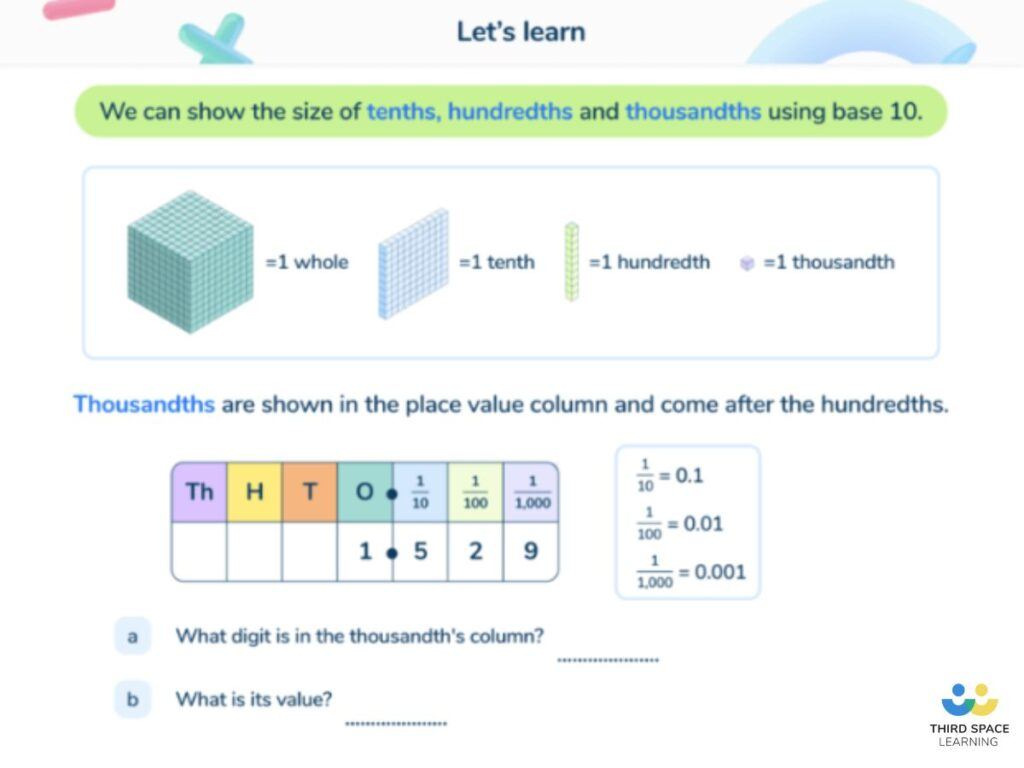
How does cognitive load theory link with Rosenshine’s principles of instruction?
According to cognitive load theory, subject-specific knowledge is harder for students to learn than general cognitive strategies because new subject knowledge must be accommodated into specific and existing schema (Clark et al., 2011).
The main purpose of reducing students’ extraneous cognitive load is to enable them to invest more cognitive resources into germane load which allows them to integrate new knowledge into their long term memories.
Instructional design is key to achieving this and Rosenshine’s principles of instruction offer a useful framework to reduce students’ extraneous cognitive load. The following principles most closely align with cognitive load theory.
Begin each lesson with a short review of previous learning
Making explicit links between the new material and prior learning encourages schema activation and makes it easier for students to assimilate the new information. This technique reduces extraneous cognitive load as pupils do not need to spend time trying to make their own links with their prior knowledge.
For example, a lesson on calculating averages from a frequency table could begin with either calculating averages from discrete data or describing what each type of average is designed to show.
Read more: Retrieval practice
Limit the amount of material students receive at one time
If too much information is presented to pupils at one time, one or more of the working memory components can become overloaded and inefficient. New information is less likely to be transferred from the short-term memory to the long-term memory when this occurs. For this reason, it would be better to separate out the teaching of multiplying, dividing, adding and subtracting fractions so that students can master one of these skills before moving on to the next.
Give clear and detailed instructions and explanations
This enables students’ attention to be directed to the most important information and reduces the mental effort required to understand the lesson content. If a teacher’s instructions are not clear or include unnecessary details, students must spend time and mental effort selecting what is important or deciphering explanations.
Provide models of worked-out problems
This directly relates to the worked-example effect. Providing students with model answers allows them to focus on understanding each line of the method instead of directing their attention towards decision-making or a trial and error approach. There are many topics that can be taught very successfully through worked solutions in maths, such as ratio, operations with fractions, finding the nth term, and solving equations.
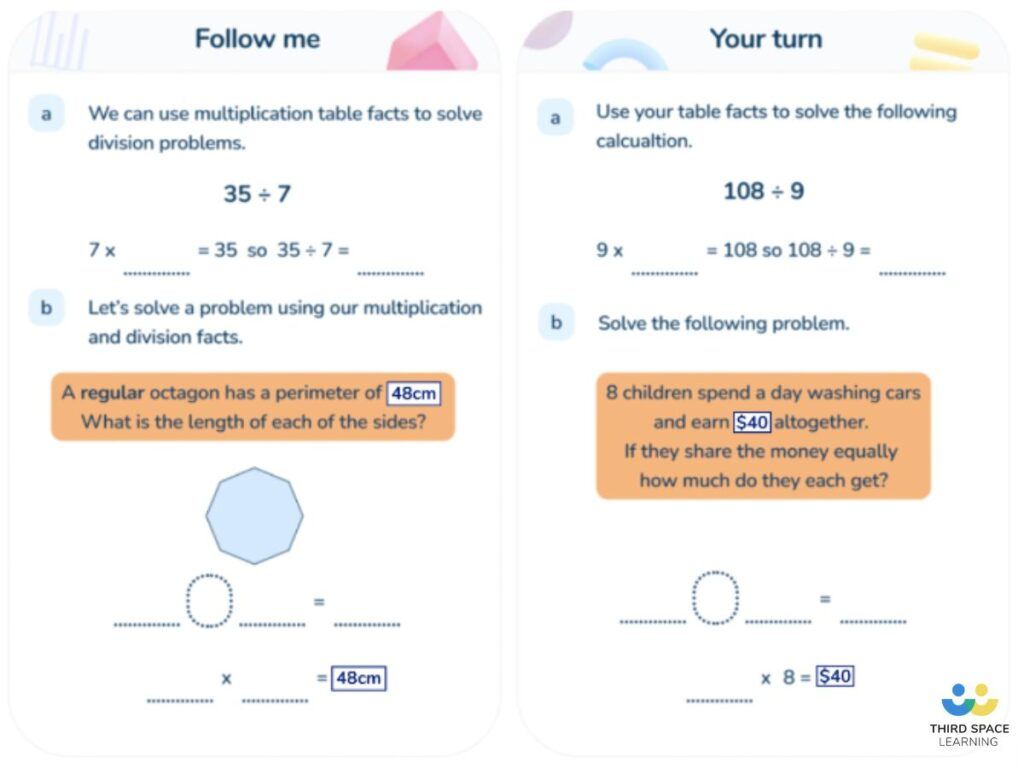
The impact of students’ emotions on cognitive load
A relatively recent development in cognitive load theory is the role that students’ emotions play in determining cognitive load (Plass and Kalyuga, 2019). Emotions that lead to an increase in motivation will cause students to invest more mental effort in germane load.
However, many emotions add to students’ extraneous cognitive load and directly impact the encoding, storage and retrieval of cognitive resources. Exam anxiety or maths anxiety are two common examples; the effort of managing those emotions could otherwise be used to directly benefit the learning process.
Taking time away from teaching to reduce students’ anxiety by engineering opportunities for success and reflection is likely to be worthwhile and an effective use of lesson time in the long run.
At Third Space Learning, tutoring is delivered by Skye, the AI maths tutor, which offers students a low-stakes, safe environment in which they are free to make mistakes. Skye has been trained to use a range of positive learning strategies to build students’ confidence and a growth mindset, informed by our decade of experience delivering online tutoring and the pedagogy expertise of the team of teachers behind Skye.
Read more: What is a growth mindset
The expertise reversal effect
Novice learners are more likely to experience a high intrinsic cognitive load than expert learners. This means that novice learners have less cognitive resources available for germane load and therefore require greater reductions in extraneous cognitive load.
Research has not only shown that extraneous cognitive load is less of a concern for expert learners, it has also shown that they benefit from tasks that are high in extraneous load. For example, expert learners benefit from less structured and learner-controlled environments with problem-solving activities, while novice learners prefer structured environments with explicit instruction (Chandler et al., 2011).
The expertise reversal effect can also be seen when activating prior knowledge. Mobilisation is most effective for novice learners while perspective-taking is most effective for expert learners. Mobilisation requires students to be directed to recall specific prior knowledge, normally in the form of a ‘brain dump’ (e.g. write down everything you can remember about Frankenstein’s monster). Perspective-taking requires learners to activate an existing schema from a given perspective (e.g. how would Frankenstien’s monster describe himself).
Cognitive load theory: tips for teachers
Chandler et al. (2011) found that animations were more effective than static images at improving students’ ability to transfer new knowledge to different contexts. They also found that spoken text was more effective than written text for learning factual knowledge.
To best take advantage of the principles of cognitive load, this is what we recommend:
- Direct instruction instead of discovery-based learning for novice learners
- Modeling through worked examples
- Scaffolding and presenting partial solutions
- Presenting images with narration
- Removing redundant information and images from slides and worksheets
- Provide opportunities for success to reduce anxiety
- Include animated images where possible and verbal explanations
- Use perspective-taking to activate prior learning for expert learners
- Teach using an I do, we do, you do approach
Cognitive load theory: tips for students
And here’s what to advise your students:
- Create a learning environment free from distractions
- Put your mobile phone out of sight when you are working
- Work in silence if you are reading or writing
- Do not watch TV or listen to music when you are working
- Focus on one learning activity at a time
- Watch your teacher when they are talking and make notes afterwards
- Ask your teacher how new topics relate to previous ones
- Use model answers and worked-solutions to learn new techniques
References
Ayres, P. and Paas, F., 2012. Cognitive load theory: New directions and challenges. Applied Cognitive Psychology, 26(6), pp.827-832.
Baddeley, A.D. and Hitch, G., 1974. Working memory. In Psychology of learning and motivation (Vol. 8, pp. 47-89). Academic press.
Chandler, P., Kirschner, P.A. and Ayres, P., 2011. Contemporary cognitive load theory research: The good, the bad and the ugly. Computers in Human Behavior, 27(1), pp.99-105.
Clark, R.C., Nguyen, F. and Sweller, J., 2011. Efficiency in learning: Evidence-based guidelines to manage cognitive load. John Wiley & Sons.
Mayer, R.E., 1996. Learners as information processors: Legacies and limitations of educational psychology’s second.. Educational psychologist, 31(3-4), pp.151-161.
Plass, J.L. and Kalyuga, S., 2019. Four ways of considering emotion in cognitive load theory. Educational Psychology Review, 31, pp.339-359.
Sweller, J., 2011. Cognitive load theory. In Psychology of learning and motivation (Vol. 55, pp. 37-76). Academic Press.Van Merrienboer, J.J. and Ayres, P., 2005. Research on cognitive load theory and its design implications for e-learning. Educational Technology Research and Development, 53(3), pp.5-13.
Cognitive load theory FAQs
It is a theory developed by John Sweller to explain why some cognitive tasks are more difficult than others due to the cognitive load they place on our limited working memory.
Intrinsic load: the relative difficulty of a task compared to a learners’ expertise.
Extrinsic load: the difficulty of the task due to its instructional design.
Germane load: the effort required for schema construction or to automate a new process.
This occurs when an element of the working memory or a type of cognitive load reaches its capacity.
Use techniques and resources that make it as easy as possible for students to achieve the learning outcomes for each lesson. Minimise the impact of redundant information and distractions.
DO YOU HAVE STUDENTS WHO NEED MORE SUPPORT IN MATHS?
Skye – our AI maths tutor built by teachers – gives students personalised one-to-one lessons that address learning gaps and build confidence.
Since 2013 we’ve taught over 2 million hours of maths lessons to more than 170,000 students to help them become fluent, able mathematicians.
Explore our AI maths tutoring or find out about maths intervention programmes for your school.



